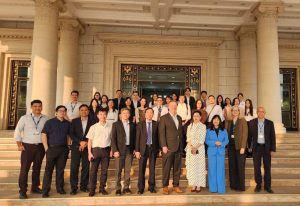Publication by VinUniversity College Of Health Sciences’ Lecture in American Journal of Physiology
Abstract
Hyperphosphatemia is the primary risk factor for vascular calcification, which is closely associated with cardiovascular morbidity and mortality. Recent evidence showed that oxidative stress by high inorganic phosphate (Pi) mediates calcific changes in vascular smooth muscle cells (VSMCs). However, intracellular signaling responsible for Pi-induced oxidative stress remains unclear. Here, we investigated molecular mechanisms of Pi-induced oxidative stress related with intracellular Ca2+ ([Ca2+]i) disturbance, which is critical for calcification of VSMCs. VSMCs isolated from rat thoracic aorta or A7r5 cells were incubated with high Pi-containing medium. Extracellular signal-regulated kinase (ERK) and mammalian target of rapamycin were activated by high Pi that was required for vascular calcification. High Pi upregulated expressions of type III sodium-phosphate cotransporters PiT-1 and -2 and stimulated their trafficking to the plasma membrane. Interestingly, high Pi increased [Ca2+]i exclusively dependent on extracellular Na+ and Ca2+ as well as PiT-1/2 abundance. Furthermore, high-Pi induced plasma membrane depolarization mediated by PiT-1/2. Pretreatment with verapamil, as a voltage-gated Ca2+ channel (VGCC) blocker, inhibited Pi-induced [Ca2+]i elevation, oxidative stress, ERK activation, and osteogenic differentiation. These protective effects were reiterated by extracellular Ca2+-free condition, intracellular Ca2+ chelation, or suppression of oxidative stress. Mitochondrial superoxide scavenger also effectively abrogated ERK activation and osteogenic differentiation of VSMCs by high Pi. Taking all these together, we suggest that high Pi activates depolarization-triggered Ca2+ influx via VGCC, and subsequent [Ca2+]i increase elicits oxidative stress and osteogenic differentiation. PiT-1/2 mediates Pi-induced [Ca2+]i overload and oxidative stress but in turn, PiT-1/2 is upregulated by consequences of these alterations.
Authors: Tuyet Thi Nguyen and other authors
Read more about the article here
Read more about the author’s Tuyet Thi Nguyen publications here



![[Job Opening]: Teaching Assistant for Research Minicourse Development at VinUniversity](https://vinuni.edu.vn/research/wp-content/uploads/2024/07/hiring-7062502_1280-300x143.jpg)